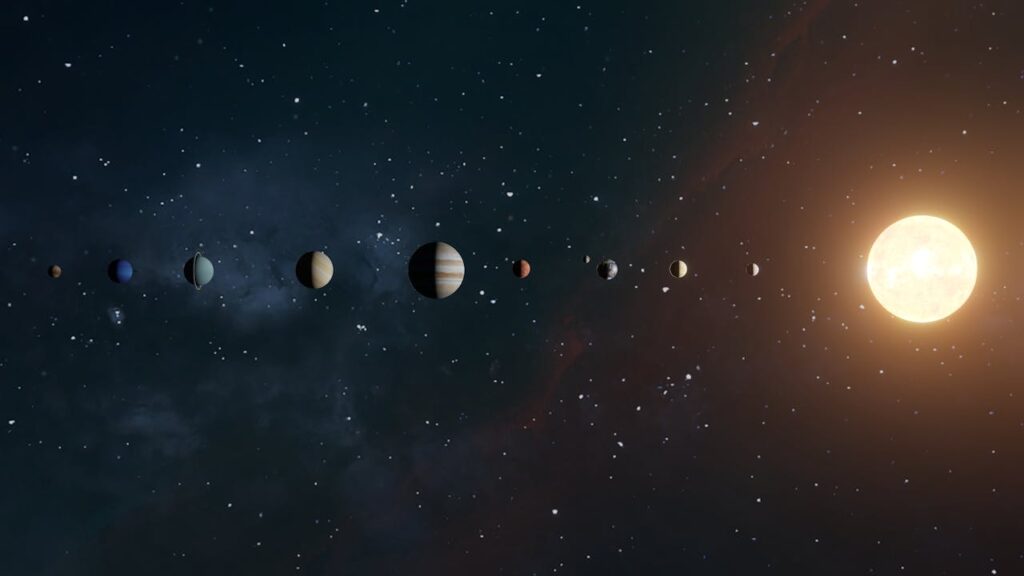The universe is an immense and complex system that encompasses everything in existence, including all matter, energy, galaxies, stars, planets, and the physical laws that govern them. It’s thought to have begun with the Big Bang around 13.8 billion years ago, and it continues to expand. The observable universe is estimated to be about 93 billion light-years in diameter.
Within the universe, our solar system is just one of countless systems. Here’s a detailed look at the planets in our solar system:
1. Mercury
- Type: Terrestrial planet
- Size: Smallest planet in the solar system.
- Distance from Sun: 57.9 million km (0.39 AU)
- Day Length: 58.6 Earth days
- Year Length: 88 Earth days
- Atmosphere: Very thin, composed mainly of oxygen, sodium, hydrogen, helium, and potassium.
- Surface: Rocky, with many craters, resembling the Moon.
- Temperature: Ranges from -173°C at night to 427°C during the day.
2. Venus
- Type: Terrestrial planet
- Size: Similar in size to Earth.
- Distance from Sun: 108.2 million km (0.72 AU)
- Day Length: 243 Earth days (longer than its year)
- Year Length: 225 Earth days
- Atmosphere: Thick and toxic, mostly carbon dioxide with clouds of sulfuric acid.
- Surface: Volcanic, with mountains, valleys, and extensive lava plains.
- Temperature: Extremely hot, around 465°C, hotter than Mercury due to the greenhouse effect.
3. Earth
- Type: Terrestrial planet
- Size: Largest of the terrestrial planets.
- Distance from Sun: 149.6 million km (1 AU)
- Day Length: 24 hours
- Year Length: 365.25 days
- Atmosphere: Nitrogen (78%), oxygen (21%), with traces of argon, carbon dioxide, and water vapor.
- Surface: 71% water, with diverse landscapes including mountains, forests, deserts, and ice caps.
- Temperature: Average surface temperature is around 15°C.
4. Mars
- Type: Terrestrial planet
- Size: Half the diameter of Earth.
- Distance from Sun: 227.9 million km (1.52 AU)
- Day Length: 24.6 hours
- Year Length: 687 Earth days
- Atmosphere: Thin, composed mostly of carbon dioxide, with nitrogen and argon.
- Surface: Rocky, with canyons, volcanoes, and polar ice caps. Known as the “Red Planet” due to iron oxide (rust) on its surface.
- Temperature: Ranges from -125°C in winter to 20°C in summer.
5. Jupiter
- Type: Gas giant
- Size: Largest planet in the solar system.
- Distance from Sun: 778.5 million km (5.2 AU)
- Day Length: 10 hours
- Year Length: 11.86 Earth years
- Atmosphere: Mostly hydrogen and helium, with traces of methane, water vapor, and ammonia.
- Surface: No solid surface; composed mostly of thick clouds of gas and a possible liquid metallic hydrogen core.
- Notable Features: Great Red Spot, a giant storm larger than Earth.
- Temperature: Cloud tops at around -145°C.
6. Saturn
- Type: Gas giant
- Size: Second-largest planet in the solar system.
- Distance from Sun: 1.4 billion km (9.58 AU)
- Day Length: 10.7 hours
- Year Length: 29.5 Earth years
- Atmosphere: Mostly hydrogen and helium, with traces of methane, ammonia, and water vapor.
- Surface: No solid surface; has a complex system of rings made of ice and rock.
- Temperature: Cloud tops at around -178°C.
7. Uranus
- Type: Ice giant
- Size: Third-largest planet in the solar system.
- Distance from Sun: 2.9 billion km (19.22 AU)
- Day Length: 17.2 hours
- Year Length: 84 Earth years
- Atmosphere: Mostly hydrogen and helium, with a higher proportion of “ices” such as water, ammonia, and methane.
- Surface: No solid surface; has a unique axial tilt of 98 degrees, causing extreme seasonal variations.
- Temperature: Around -224°C.
8. Neptune
- Type: Ice giant
- Size: Fourth-largest planet in the solar system.
- Distance from Sun: 4.5 billion km (30.07 AU)
- Day Length: 16.1 hours
- Year Length: 165 Earth years
- Atmosphere: Similar to Uranus, with hydrogen, helium, and methane giving it a blue color.
- Surface: No solid surface; has the fastest winds in the solar system, reaching up to 2,100 km/h.
- Temperature: Around -214°C.
Dwarf Planets (e.g., Pluto):
- Pluto: Once considered the ninth planet, Pluto is now classified as a dwarf planet. It orbits in the Kuiper Belt, a region of the solar system beyond Neptune filled with small icy bodies.
These planets, along with their moons, rings, and other celestial objects like asteroids and comets, make up our solar system, which is just a tiny part of the vast universe.


